Eucalypts – Background
Introduction
Gum trees (eucalypts) are the essence of the Australian flora. Their range extends from sub-alpine areas to wet coastal forests, temperate woodlands and the arid inland. In fact, the only major environment where eucalypts are absent is probably rainforest. There are about 12 species which occur naturally outside of Australia but around 700 are Australian endemics. Only 2 species are not found in Australia. One of these, Eucalyptus deglupta, is the only eucalypt to be found growing naturally in the northern hemisphere, occurring in the southern Phillipines (as well as in New Guinea and parts of Indonesia).
Even Australians who wouldn’t know a Banksia from a Begonia know what a gum tree looks like and smells like. Soldiers returning by ship from the first and second world wars are rumoured to have been able to smell the aroma of the eucalypt before land was visible on the horizon. Most Australians may not be able to identify a particular species (there are hundreds of them, after all!) but they will know “that’s a eucalypt”.
Although often thought of as applying to the genus Eucalyptus, the term “eucalypt” is now broadly used to include the closely related genera Angophora and Corymbia. Corymbia is, in fact, a relatively new genus (1995) which contains 113 species, 80 of which were formerly within Eucalyptus. Angophora consists of about 13 species. Although rarely encountered, there are four other genera within the ‘eucalypt group’ – Stockwellia and Allosyncarpia (each comprising a single species and confined to Queensland rainforests), Eucalyptopsis (two species) and Arillastrum (1 species) neither of which occur in Australia.

There are a number of differences which serve to distinguish the three main “eucalypt” genera. The following are the most obvious features which separate them but they are only general and there may be exceptions:
- Eucalyptus and Corymbia; Adult leaves alternate (Fig 1)
- Angophora; Adult leaves opposite (Fig 1)
- Eucalyptus and Corymbia; Flowers have a cap (operculum) which falls off as the flowers open (Fig 2)
- Angophora; Flowers do not have a cap
- Angophora and Corymbia; Flowers occur in “corymbs”, a structure where flower stalks arise from different levels on the stem but all flowers finish in more or less the same plane (Fig 3)
The term “gum tree” is derived from the habit of some eucalypt species to exude a sticky, gum-like substance from the trunk. This is by no means a general characteristic but “gum tree” has become a common generic term for most eucalypts. A number of other common names have been applied to certain groups of eucalypts based on features such as bark type, timber characteristics or growth habit. Some names in common usage are:
- Apple – A name used by early European settlers due to a similarity in appearance of some plants to apple trees (eg. Angophora bakeri, Narrow-leaved apple)
- Ash – Timber is similar to the European ash trees (eg. Eucalyptus regnans, Mountain ash)
- Blackbutt – The lower part of the trunk has persistent bark which is usually black due to past fires (eg. Eucalyptus pilularis, Blackbutt)
- Bloodwood – Timber often has pockets of a dark red gum known as kino (eg. Corymbia eximia, Yellow bloodwood)
- Box – Bark is retained on the tree and is short fibred; plates of bark may shear off with age (eg. Eucalyptus melliodora (Yellow box)
- Ironbark – Bark is retained on the tree and is hard and deeply furrowed (eg. Eucalyptus crebra, Narrow-leaved ironbark)
- Mallee – Multi-stemmed trees, usually fairly small in height (eg. Eucalyptus albida, White-leaved mallee)
- Peppermint – The oil in the leaves has a peppermint-like aroma (eg. Eucalyptus dives, Broad-leaved peppermint)
- Ribbon Gum – Bark is deciduous and is shed in long strips which often hang from the branches (eg. Eucalyptus viminalis, Ribbon gum)
- Scribbly Gum – Bark is deciduous and the smooth trunk is marked with “scribbles” caused by an insect larva (eg. Eucalyptus sclerophylla, Scribbly gum)
- Stringybark – Bark is retained in long fibres which can be pulled off in “strings” (eg. Eucalyptus eugenioides, Thin-leaved stringybark)
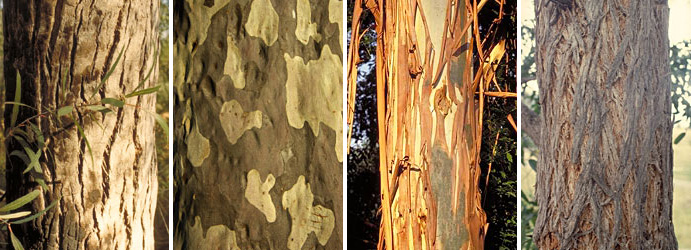
Some Eucalypt Bark Types
From left – Angophora bakeri (Narrow-leaved apple),
Corymbia maculata (Spotted gum),
Eucalyptus saligna (Sydney blue gum),
Eucalyptus eugenioides (Thin-leaved stringybark).
Photos: Brian Walters
Characteristics
The eucalypts are within the plant family Myrtaceae and can number among their relatives such well known Australian genera as Callistemon (bottlebrushes), Melaleuca (paperbarks), Leptospermum (tea trees) and Syncarpia (turpentine).The adult leaves of the majority of eucalypts are sickle-shaped and arranged alternately on the branches. They have special glands containing volatile oils which, in some species, are exploited commercially. The leaves of certain species (eg. E.camaldulensis, River red gum; E.punctata, Grey gum; E.viminalis, Ribbon gum) are important as the food of the Koala, a tree-dwelling marsupial.
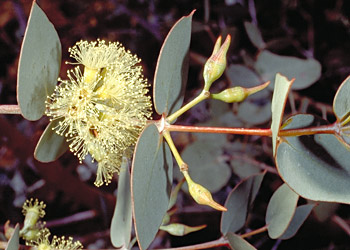 |
| Eucalyptus gillii, showing juvenile foliage, buds and flowers Photo: Brian Walters |
The juvenile leaves are usually quite different from the adult ones, are often greyish in colour and opposite rather than alternate. These leaves are usually superseded by the adult leaves early in the tree’s development but, in a few cases, they may persist into the adult stage of growth. E.cinerea (Argyle apple) is perhaps the best known of these and its round, silvery foliage is sought as decorative foliage in cut flower arrangements. The Tasmanian blue gum (E.globulus) and the Curly mallee (E.gillii) are two others that retain the juvenile foliage for a considerable time.Like many related plants, the conspicuous parts of the flowers of the majority of the species are the stamens, the male parts of the flowers. These surround the central stigma which arises from the flower’s ovary. In Eucalyptus and Corymbia the flower buds are covered by an operculum, or bud cap, formed by the fused sepals (outer operculum) and fused petals (inner operculum). As the flower opens the cap is shed. It is, in fact, the operculum which gives Eucalyptus its name (eu, well and calyptos covered). In Angophora the cap is not present and the flowers develop with small petals.After flowering, hard, woody seed pods develop. The shape and size of these pods are important aids in identifying species. It is often possible to identify a tree, even when foliage and flowers may be many metres above the ground, by collecting pods lying around its base. The pods usually contain a number of true seeds and an amount of infertile “chaff”. The seeds are generally larger and more deeply coloured than the chaff. In most cases seed matures within 12 months of flowering but is retained on the tree until stimulated to be shed by the heat from a fire or by the death of the plant.

Some Eucalypt Buds and Fruits
Clockwise from top left
Buds of Eucalyptus lehmannii showing the long, narrow operculum
Buds of Eucalyptus amplifolia
Fruit of Eucalyptus erythrocorys
Fruit of Eucalyptus lehmannii
Photos: Brian Walters
Another well-known feature of many eucalypts is their ability to recover quickly from the effects of bushfires. There are three mechanisms of recovery:
- Regeneration from seed.
- Regeneration from epicormic shoots emerging from the trunk and branches.
- Regeneration by shooting from a lignotuber at, or just below ground level.
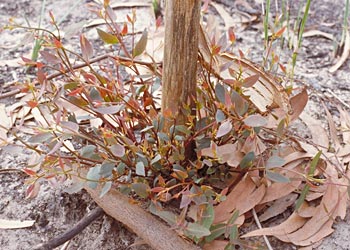 |
| Regeneration from a lignotuber Photo: Brian Walters |
Some species, notably those like Mountain ash (E.regnans) from wetter forests, rely solely on seed to regenerate. The long-term survival of these species can be at risk if fires occur too frequently (i.e. at intervals that do not allow sufficient time for seedlings to grow to maturity, flower and set seed. Those species that regenerate vegetatively from the trunk or lignotubers are more readily able to cope with more frequent fire. However, even with these species, regeneration from seed is important to ensure genetic diversity of the plant population.
Commercial Uses of Eucalypts
The most important commercial use of eucalypts is in forestry and this is an area where there has been considerable conflict between conservation and timber interests in the last 20 years or so, particularly as resistance to woodchipping and the move to preserve old growth forests have gained momentum.Timber production from eucalypts is carried out in Australia and overseas. Many different species are used both from natural forests and from plantations. Eucalypt plantations can be found in more than 90 countries with the largest overseas plantations being in Brazil which has over 1 million hectares. Some of the uses for eucalypts are:
- Building (for termite resistance); eg. E.camaldulensis, E.marginata
- Furniture; eg. C.maculata, E.globulus
- Woodchips; eg. E.camaldulensis, E.globulus, E.viminalis
- Paper; eg. E.botryoides, E.camaldulensis, E.grandis
- Fuel; eg. E.camaldulensis, E.globulus, E.saligna
Another commercially important feature of eucalypts is the extraction of the oils contained in the foliage. Surprisingly, production of eucalypt oil is greater overseas than in Australia. Portugal and Spain together produce more than 50% of the world’s supply with Australian production being around 5%. Eucalypt oil has been used in medicine, industry and for perfumes and this is outlined in the tab titled: Volatile Oils from Eucalypts.The flowers of all eucalypts contain nectar and many species are important in the beekeeping industry. Honey is often marketed under the name of the main species involved in its production (eg. Yellow box, Red ironbark).
Expatriate Gum Trees
Large scale planting of Eucalypts overseas is not always welcomed by the local population. The following extracts illustrate the extent of the problem (from “Science Comes to the Gum Tree”, Dr Anne-Maria Brennan, University of Kent, Canterbury, in Waste Disposal and Water Management in Australia, April 1992).
“In some parts of the world eucalypts have been heralded as the saviour of forests, for their rapid growth makes them a naturally renewable resource of timber and wood for fuel, helping to obviate the need for large-scale deforestation. But things are different in other places where the non-native trees are regarded as little more than weeds which threaten to oust the natural vegetation of the area.”
……..As a result of this, eucalypts have in recent times become the focus of riots and open hostility between farmers, forestry officials and funding bodies. ……….In Spain, a Society which promotes the cause against non-native introduced species has even called itself the Phorocantha Club, after the name of the bark beetle which infects and kills the much-hated eucalyptus!
Those who campaign against eucalyptus do so on the basis that the trees are aggressive non-natives that lower the water table, poison the soil and deplete it of nutrients.”
The situation is a little less volatile where eucalypts have been planted mainly for landscaping. In California, for example, the eucalypt is so common that many people believe that it is a Californian native. With the exception of E.globulus, which is listed among the exotic pest plants of greatest concern by the California Exotic Pest Plant Council, eucalypts seem to have been generally accepted in California for their intrinsic qualities but there are understandable concerns about the widespread use of what is, after all, an alien species. An excellent account of the history, uses and environmental issues of Californian eucalypts can be found in The Eucalyptus of California: Seeds of Good or Seeds of Evil?
Eucalypts – Propagation
Introduction
Eucalypts are usually propagated from seed. Vegetative propagation (i.e. cuttings), although possible under certain circumstances (such as the use of juvenile foliage) has practical limitations and is of little interest to the average grower. Some work on grafting has been carried out in an effort to extend the range where desirable species can be grown or for early flowering of ornamental species.
Seed
 |
| Seeds (and chaff) of the River red gum (Eucalyptus camaldulensis) Photo: Brian Walters |
The seed capsules need to be collected and placed in an open container in a warm position until the fine seed is released. This should occur in 2-3 days. For best results, the capsules should be at least 12 months old (ie. the most recently formed capsules are best avoided). The seed capsules usually contain true, viable seed together with a considerable quantity of infertile seed known as ‘chaff’. The true seed is easily identified as it is usually larger and darker in colour than the chaff. Generally it is not necessary to separate the true seed from the chaff; both can be sown together and the chaff simply becomes part of the propagating mix.
Germination of the seed of Angophora, Corymbia and Eucalyptus species is usually quite easy by normal seed raising methods. In most cases no special pretreatment is needed, however, germination is improved with some high altitude species if the seed is “stratified” for a period of time. Stratification involves exposing the seed to a period of low temperature and is beneficial for those species normally found at high altitudes. The simplest method is to sow the seed normally in a punnet or pot, cover it and place the container in a refrigerator. The period required under stratification varies with the species and can range from 3 weeks (E.perriniana) up to 10 weeks (E.delegatensis).

A common method used for germination of eucalypts and related plants is the “bog method” where the pot containing the seeds is placed into a saucer of water until germination occurs. This results in moisture reaching the seeds by capillary action and ensures that the seeds do not dry out.
Although germination will occur right throughout the year, germination is usually slower, more uneven and percentage not as high during the period from May to mid-August. During this period germination may take from 2 to 3 weeks, compared to 3 to 10 days during spring and summer.
Grafting
A number of horticulturally desirable species are found in the south-west corner of Australia and have proven to be unreliable in humid, coastal areas of the eastern states. Species in this category include the popular “Red flowering gum” (C.ficifolia), the “Mottlecah” (E.macrocarpa) and E.caesia. All of these have large, colourful flowers and are desirable garden subjects. Grafting has shown some potential for extending the horticultural range of some of these species but the long term viability is not certain. Most work has been done on C.ficifolia using the related C.gummifera as rootstock.
General Propagation
Further details on general plant propagation can be found at the Society’s Plant Propagation Pages.
Eucalypts – Cultivation
Introduction
Eucalypts have proven to be reliable and adaptable over a wide range of environments but many are too large for small suburban properties so some care is needed in their selection. In addition, consideration needs to be given to the natural environment and climate of the species being considered. If this is vastly different to that of the local environment, alternative selections may be more satisfactory. The table below summarises features of about 20 popular species as well as indicating some selection criteria for each.
Eucalypts for Cultivation
|
Species
|
Common Name
|
Height (m)
|
Flower Colour
|
Natural Distribution
|
Comments
|
|---|---|---|---|---|---|
|
Angophora bakeri
|
Narrow-leaved apple
|
|
White
|
NSW
|
Rough, black trunk. Well-displayed flowers
|
|
Angophora costata
|
Sydney red gum
|
|
White
|
NSW, Qld
|
Beautiful pink/orange trunk when bark is shed. Characteristic “twisted” habit
|
|
Angophora hispida
|
Dwarf apple
|
|
White
|
NSW
|
Spectacular in flower. Bright reddish-coloured new growth
|
|
Corymbia citriodora
|
Lemon-scented gum
|
|
White
|
Qld
|
Stately and popular tree but too large for normal suburban-sized properties
|
|
Corymbia ficifolia
|
Red flowering gum
|
|
Red, Orange, White
|
WA
|
Unreliable in tropical/sub-tropical areas
|
|
Corymbia gummifera
|
Red bloodwood
|
|
White
|
Vic, NSW, Qld
|
A hardy tree over a wide area but too large for smaller gardens
|
|
Corymbia maculata
|
Spotted gum
|
|
White
|
Vic, NSW, Qld
|
Very beautiful tree with attractive bark. Best in large gardens
|
|
Corymbia ptychocarpa
|
Swamp bloodwood
|
|
White, Pink, Red
|
WA, NT, Qld
|
Excellent colourful tree for warm, humid climates
|
|
Eucalyptus caesia
|
Gungurru
|
|
Pink, Red
|
WA
|
Unreliable in tropical and sub-tropical areas. “Silver Princess” is a good weeping form
|
|
Eucalyptus camaldulensis
|
River red gum
|
|
White
|
All states
|
The most widespread eucalypt. For large gardens
|
|
Eucalyptus curtisii
|
Plunkett mallee
|
|
White
|
Qld
|
Good for small gardens in a range of climates
|
|
Eucalyptus erythrocorys
|
Illyarrie
|
|
Yellow
|
WA
|
Spectacular flowering tree which is best in areas of low summer rainfall
|
|
Eucalyptus forrestiana
|
Fuchsia mallee
|
|
Yellow
|
WA
|
Flowers are relatively small but the species has spectacular, red buds and fruit
|
|
Eucalyptus globulus
|
Tasmanian blue gum
|
|
White
|
Vic, Tas
|
Attractive grey-green foliage. For large gardens only
|
|
Eucalyptus leucoxylon “Rosea”
|
Yellow gum
|
|
Red, pink
|
SA
|
Most reliable of red flowering gums for humid districts
|
|
Eucalyptus macrocarpa
|
Mottlecah
|
|
Red
|
WA
|
Huge flowers/silvery foliage. Unreliable in tropical and sub-tropical areas
|
|
Eucalyptus miniata
|
Darwin woollybutt
|
|
Orange
|
WA, NT, Qld
|
Best in tropical and sub-tropical areas
|
|
Eucalyptus rubida
|
Candle bark
|
|
White
|
Qld, NSW,Vic, Tas. SA
|
Cold tolerant tree with a beautiful white trunk. For large gardens
|
|
Eucalyptus sclerophylla
|
Scribbly gum
|
|
White
|
NSW
|
Beautiful white trunk with “scribbles”. Fairly slow growing
|
|
Eucalyptus scoparia
|
Wallangarra white gum
|
|
White
|
NSW
|
Quick growing. Beautiful white trunk and weeping foliage
|
|
Eucalyptus youngiana
|
Large-fruited mallee
|
|
Yellow
|
WA
|
Spectacular shrub which is best in areas of low summer rainfall
|
| Key to Distribution: WA=Western Australia; SA=South Australia; Vic=Victoria; Tas=Tasmania; NSW=New South Wales; Qld=Queensland; NT=Northern Territory |
|||||
Pests of Eucalypts
There are quite a number of pests which can attack eucalypts and which may require control in a garden situation. Leaf chewing insects are probably the main concern but, unless damage is severe, there is little reason to resort to chemical controls. Regular observation will enable removal by hand for trees which are being established and, if a few chewed leaves can be tolerated, birds will often keep the infestations in check on larger specimens.
Sometimes insects such as “Christmas beetles” can appear in plague proportions and cause severe defoliation which is beyond the ability of the bird population to control. If access is possible, the beetles can be shaken off, collected and disposed of.
Another chewing pest that can appear in large numbers are steel-blue sawfly larvae. They do most of the damage to a tree’s foliage during the night and in daylight hours they gather into groups around small branches. If they are accessible at these times they can be removed by cutting off the branches where they cluster together.
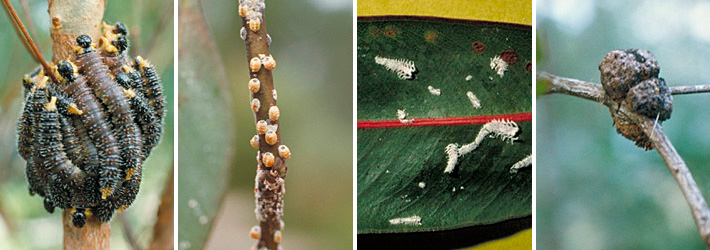
Some Pests of Eucalypts
From left – Steel-blue sawfly larvae; Scale insects;
Lerp-forming psyllids; Eucalypt gall
Photos: Brian Walters
Psyllids (including lerp-forming species) and scale can also cause problems. These are sap-sucking insects and can cause a tree to lose vigour. Again, birds will normally keep them under control but often a strong jet of water directed at the pests will also dislodge them. This may need to be carried out several times. If this is not successful, the traditional treatment with white oil is usually effective.
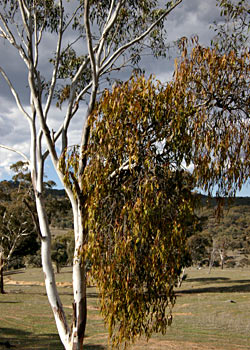
Photo: Brian Walters
Some insects lay their eggs into leaves or twigs forming “galls” in which the next generation develop. The galls form as a response by the plant to secretions by the particular insect. To prevent hatching of the adults, galls can be removed by hand and burnt. Often, however, only a few galls occur and are unlikely to damage the tree to any serious extent. They are sometimes attractively coloured and of interesting shapes which can be appreciated as part of the local garden environment. Wasps, flies and thrips are among the gall-forming insects.
People sometimes worry about the appearance of mistletoe on a tree but this is usually unwarranted. These parasitic plants are commonly seen on eucalypts as ovoid-shaped clumps of foliage hanging from the tree’s branches.
Mistletoes and their hosts have evolved together and, unless the host tree is unhealthy, one or two mistletoe clumps should not cause any problems. In fact they can also be enjoyed as part of the overall garden environment and the fruit may attract the beautiful mistletoe bird.
Once a tree gets to a reasonable size, control of pests by hand removal will be impractical. If serious damage is being caused, it may be necessary to seek advice from the local Agricultural Department.
For further information on mistletoes, see the excellent two-part article by Marion Jarratt published in Australian Plants online. Part 1 is here and Part 2 is here.
Volatile Oils from Eucalypts
Ken Stuckey
The following article is based on one which was published in the November 1985 issue of the newsletter of the Eucalyptus Study Group. Some minor editorial amendments have been made where necessary to bring details up to date.
Essential oils are the aromatic ‘essences’ found in various plant parts. Because they evaporate when exposed to the air at ordinary temperatures they are called volatile or essential oils. These oils possess characteristic odours, are colourless, insoluble in water and are separated from plant material by steam distillation or solvent extraction.
Essential oils from the leaves of eucalypts have attracted interest since the earliest days of settlement in Australia. One of the first articles of export from the newly established colony of New South Wales in 1788 was a quarter of a gallon of an essential oil steam-distilled from the leaves of a eucalypt (Eucalyptus piperita) growing on the shores of Port Jackson.
The therapeutic properties of the Australian flora so fascinated the botanist Baron Ferdinand von Mueller that he prompted a Victorian pharmacist colleague, Joseph Bosisto, to investigate the commercial production of eucalyptus oil. Bosisto responded and, in 1852, commenced operations at Dandenong, Victoria. This was the beginning of the Australian essential oil industry. Between 1854 and 1891 Bosisto displayed commercial eucalyptus oils at no less than seventeen exhibitions around the world. Through his pioneering efforts the eucalyptus industry spread to other states as the demand grew and its products became known in world trading centres. By 1900 the industry was firmly established, and for the next fifty years Australia remained the world’s largest supplier of eucalyptus oil.
One problem confronting the industry from the outset was the variation in the oils marketed. At the turn of the century, new light was thrown on the problem by two early curators of the Museum of Applied Arts and Sciences, Sydney, in a series of investigations into the botanical classification of the eucalypts and their oils. Further progress was made by successive curators at the Museum with the discovery of chemical variation within species, a phenomenon which had been troublesome to distillers. The curators found that populations of E.dives at Braidwood yielded piperitone and phellandrene, whereas cineole-rich oils were obtained from populations of the same species at Tumbarumba.
There are over 700 species and varieties of the eucalypt but only about 20 have been exploited commercially and less than a dozen are presently of economic importance. The commercial eucalyptus oils are broadly divided into three classes; medicinal, industrial and perfumery oils, according to their specific uses.
- Medicinal oils — the active therapeutic agent of medicinal oils is cineole, of which a minimum of 70% is required to meet commercial specifications. Medicinal oils are graded on their cineole content, and it is common practice to improve them by blending and purification. These oils are used for inhalants, embrocations, soaps, gargles, sprays, lozenges and dentrifices. Eucalypt species which contain commercial quantities of cineole are E.polybractea, E.radiata, E.dives, E.sideroxylon, E.leucoxylon, E.goniocalyx, E.viridis, E.smithii, E.cneorifolia, E.globulus, E.dumosa and E.oleosa.
- lndustrial oils — these contain phellandrene and piperitone as the principal constituents. Phellandrene oils are used in the manufacture of inexpensive disinfectants, household and industrial liquid soaps, and germicidal preparations. Piperitone oils provide the base material for the manufacture of synthetic menthol and thymol. Species used to provide these oils are E.dives, E.elata and E.radiata.
- Perfumery oils — two species of eucalypt have been exploited to supply oils for the perfumery industry: E.citriodora now (Corymbia citriodora) for citronellal and E.macarthurii for geranyl acetate and eudesmol. Extraction of these oils in Australia is no longer economically viable.
Eucalyptus Study Group
The Eucalyptus Study Group is one of a number of Study Groups within the Australian Native Plants Society (Australia). Its aim is to further knowledge about the cultivation, propagation and conservation of the eucalypts (the genera Eucalyptus, Corymbia and Angophora). Members of the Group are mainly keen amateurs with no formal horticultural or botanical knowledge, although a number of professionals in those fields also participate. As in all study groups, the members’ work is mainly carried out in their own homes and gardens and in their own spare time.
Further information about the Study Group, its activities and access to the newsletter archive can be found at the link below.
Eucalypts – Further Information
Most books dealing with Australian native plants will contain useful information on the botany and horticulture of eucalypts. There are also a number of eucalypt resources on the internet and on CD. Some of the most detailed references are listed below.
Books:
- Boland, D, Brooker, M, Chippendale, G, Hall, N, Hyland, B, Johnston, R, Kleinig, D and Turner, J (1984), Forest Trees of Australia, Thomas Nelson, Australia and CSIRO.
- Brooker, M and Kleinig, D (1990; Revised Ed.), Field Guide to the Eucalypts, Vol.1 South-eastern Australia, Inkata Press, Melbourne and Sydney.
- Brooker, M and Kleinig, D (1990), Field Guide to the Eucalypts, Vol.2 South-western and Southern Australia, Inkata Press, Melbourne and Sydney.
- Brooker, M and Kleinig, D (1994), Field Guide to the Eucalypts, Vol.3 Northern Australia, Inkata Press, Melbourne and Sydney.
- Brooker, M and Kleinig, D (1996), Eucalyptus: An Illustrated Guide to Indentification, Reed Publishers, Australia.
- Chippendale, G (1968), Eucalyptus Buds and Fruit, Australian Government Publishing Service, Canberra.
- Chippendale, G (1973), Eucalypts of the Western Australian Goldfields (and the Adjacent Wheatbelt), Australian Government Publishing Service, Canberra.
- Elliot, W. R and Jones D (1986), The Encyclopaedia of Australian Plants, Vol.4, Lothian Publishing Company Pty Ltd, Melbourne.
- Hill, K and Johnson, L (1995), A Revision of the Bloodwoods, Genus Corymbia (Myrtaceae), in Telopea, Volume 6(2-3), Royal Botanic Gardens, Sydney.
- Holliday, I and Watton, G (1989), A Gardener’s Guide to Eucalypts, Hamlyn Australia
- Kelly, S (1969), Eucalypts, Vol.1, Thomas Nelson, Australia.
- Kelly, S (1978), Eucalypts, Vol.2, Thomas Nelson, Australia.
- Prior, L and Johnson, L (1971), A Classification of the Eucalypts, Australian National University Press, Canberra.
CD-ROM:
- EUCLID; This is a computer-based, interactive identification and information system. It allows the user to quickly and easily identify any of the 324 species and subspecies of Eucalyptus and Angophora native to south-eastern Australia, i.e. New South Wales, Australian Capital Territory, Victoria, Tasmania and part of South Australia.
Journals:
Many issues of the Society’s journal “Australian Plants” contain material on eucalypts and eucalypt cultivation. Issues of particular interest are:
- Vol 8, No.61 December 1974; Small Eucalypts, with particular reference to colourful mallees.
- Vol 9, No.72 September 1977; Forms of Eucalyptus leucoxylon.
- Vol 10, No.78 March 1979; Eucalypts for arid areas; Eucalypt propagation; A close look at Eucalypt leaves; Scribbly gums; Root systems.
- Vol 11, No.88 September 1981; Descriptions and photographs of yellow-flowered species; Pests of Eucalypts.
- Vol 20, No.164 September 2000; Ornamental Eucalypts – Species for cut bud and flower production.
- Vol 22, No.176 September 2003; Eucalypts in the Goldfields.
Internet:
- Eucalyptus Study Group Newsletters – recent issues can be found here.
- Corymbia, Corymbia….Wherefore Art Thou, Corymbia? – a look at the naming controversy
- Corymbia ‘Summer Red’ and ‘Summer Beauty’
- Currency Creek Arboretum – specialist eucalypt research arboretum.
- Dyeing with eucalypts
- Eucalypt Australia – A grant making Charitable Trust that focuses on eucalypts and co-ordinates National Eucalypt Day (March 23).
- Eucalypts by Cuttings.
- Eucalypts…but not Eucalyptus – The new genus Corymbia
- Eucalyptus oil industry in the NSW Southern Highlands – A two-part article from the Southern Highland News, sourced from the archives of Berrima District Historical & Family History Society. Part 2 is here.
- Growing Native Plants – a series of plant profiles by the Australian National Botanic Gardens; includes a number of eucalypts.
- Hardy Eucalypt Page – Eucalypts for Cold Climates
- Medicinal properties and bush foods of eucalypts
- The marri, Corymbia calophylla
- Mistletoe – Part 1
- Mistletoe – Part 2
- Small-growing Eucalypts
- Small Gums for Small Gardens
- Stratification of Eucalyptus Seed
- Temperate Area Eucalypts
- When to Plant Eucalyptus Seed
 Australian Native Plants Society (Australia)
Australian Native Plants Society (Australia)
